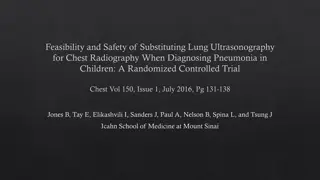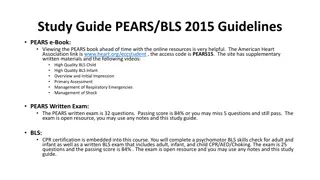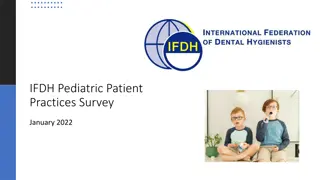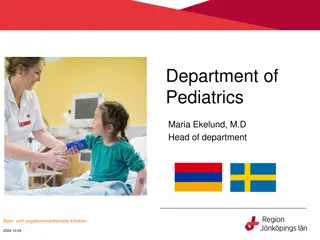Understanding Race in Pediatric Clinical Practice Guidelines
Clinical Practice Guidelines (CPGs) play a crucial role in shaping healthcare practices. This article delves into the complexities of incorporating race into pediatric clinical guidelines, emphasizing the societal constructs and implications rather than biological determinants. Critical Race Theory (CRT) in medicine provides a framework to analyze the impact of race, power dynamics, and resource distribution on health disparities. It challenges the notion of race as a biological factor and highlights the importance of embracing intersectional identities. The focus is on addressing systemic biases and barriers to improve care for all patient populations with a particular emphasis on eosinophilic gastrointestinal diseases.
Download Presentation

Please find below an Image/Link to download the presentation.
The content on the website is provided AS IS for your information and personal use only. It may not be sold, licensed, or shared on other websites without obtaining consent from the author. Download presentation by click this link. If you encounter any issues during the download, it is possible that the publisher has removed the file from their server.
E N D
Presentation Transcript
Use of Race in Pediatric Clinical Practice Guidelines Vincent Mukkada M.D. CEGIR Conference Call 7/26/23
CEGIR Diversity Committee CEGIR Diversity Historical Statement In response to longstanding, systemic racial, cultural and gender injustices that have affected health care delivery, CEGIR developed a committee to focus on diversity and inclusion in our research and education activities. These efforts intend to improve the care for underrepresented populations with EGIDs. CEGIR Diversity Mission Statement We will develop an understanding of cultural, ethnic and racial diversity and structural racism, particularly as it pertains to underrepresented populations of patients with eosinophilic gastrointestinal diseases (EGIDS); strive to examine systemic and implicit biases; identify associated barriers to our research; and integrate the knowledge into our research studies and educational initiatives, so that we can better serve all patients with EGIDs. CEGIR Diversity Vision Statement CEGIR actively promotes a culture of diversity and inclusivity in its membership, in its innovative research studies and its educational initiatives.
The article: Published In JAMA Pediatrics 2022
Background Clinical Practice Guidelines (CPGs) are typically developed by organizations to synthesize the evidence and identify best practices for clinical care Use of race can be problematic if used to blame biology/genetics for health care disparities rather than acknowledging that race is a social/political construct and that societal treatment of members of marginalized groups is more likely the cause of disparities
Background-Critical Race Theory (CRT) in medicine CRT is a sociolegal framework to examine the use of race, power, policy, and distribution of resources Tries to understand effect of environmental factors including racism on health disparities Provides framework for language/analysis of use of race in clinical guidelines
Background-Critical Race Theory (CRT) in medicine-2 key tenets First-critiques the idea of race as a biological factor for conclusions in research Race is a sociopolitical construct, not a biological fact Second-need to critique biological racial essentialism and embrace intersectional identities Race is a sociopolitical identity that is only one part of a person, but medicine has historically made major conclusions based on this one variable
Methods Search for English language, pediatric CPGs applying only to the US population from January 1, 2016 through February 2021 Final list of 846 abstracts to screen, got down to 414 full text articles to review Then did both manual search and electronic screening on a designated list of race or ethnicity terms
Methods Then got down to 126 studies for inclusion Divided use of race in 3 3 categories Background info Clinical Recs Gaps/Future Direction
Methods Then classified use of race into 3 categories Potential to Negatively influence health inequities Reinforcing the majority group as the norm / centering whiteness Using race as biological risk factor Conflating race with negative stereotype (eg diet or lifestyle) Conflating race, ethnicity, and genetic risk Establishing treating or testing thresholds or using racial coefficients
Methods Then classified use of race into 3 categories Potential to Positively influence health inequities Using race to describe health disparity Using race to describe inclusivity Establishing representative committee structures Recommending cultural humility Describing geographic risk rather than racial risk
Methods Then classified use of race into 3 categories Neutral or indeterminant Studies with both positive and negative potentials were included in both Training-used 20 standardized articles that were reviewed as a group and came to consensus on how to classify these as a way to standardize evaluation
Results Of the 126 CPGs included in final analysis, race used 175 times 73 CPGs (58% of total 126) used race in potential negative fashion 87 times (50% of total 175) 45 CPGs (38% of total 126) used race in potential positive fashion 50 times (29% of total 175) 12 CPGs use race as a way to identify gaps or future directions
Results In terms of use in Background/Epidemiology, frequently found to have potential negative impact, generally reinforcing the idea of race as a biological risk factor In terms of use in Clinical Recommendations, the most common negative potential impact was in recommending different thresholds based on race
Discussion Of the 414 screened CPGs, 288 (70%) did not address race, which is a major potential missed opportunity Authors argue for the positive potential of using CRT as a framework in the development of future CPGs to help move beyond the use of race alone and to focus on identifying and overcoming structural barriers that have been misinterpreted as being inherent to biology
Discussion Of the 414 screened CPGs, 288 (70%) did not address race, which is a major potential missed opportunity Authors argue for the positive potential of using CRT as a framework in the development of future CPGs to help move beyond the use of race alone and to focus on identifying and overcoming structural barriers that have been misinterpreted as being inherent to biology
Limitations Potential for missed CPGs based on search strategy Subjectivity of the categorizations Use of a single framework to evaluate

























